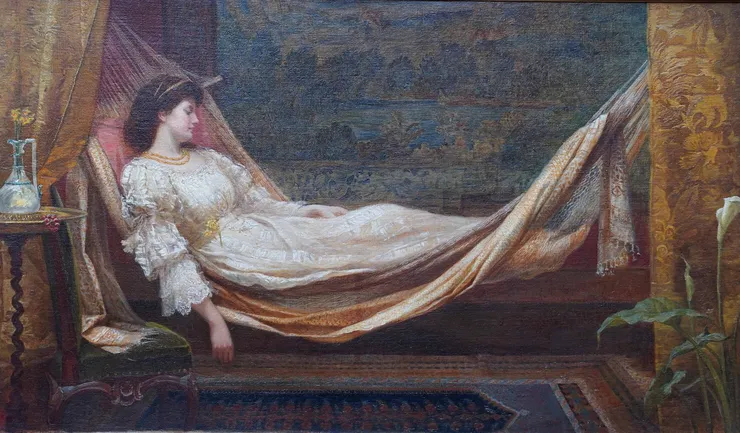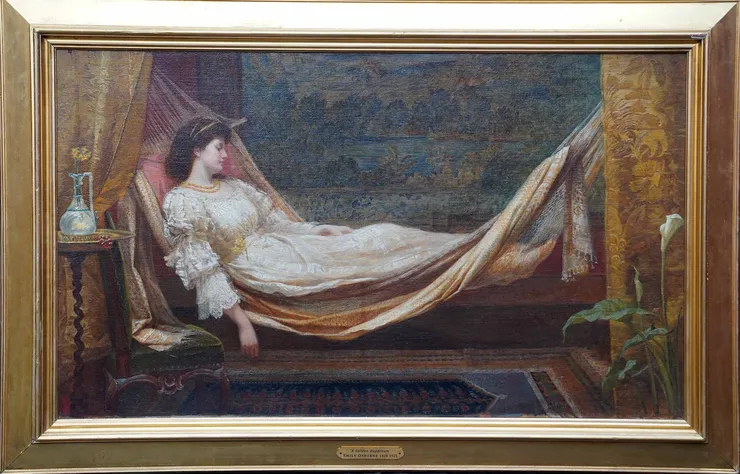Emily Mary Osborn (1828-1925)
| Artist Name | Emily Mary Osborn (1828-1925) |
|---|---|
| Title | Golden Daydream |
| Description | This stunning British Victorian Pre-raphaelite Royal Academy exhibited oil painting is by note female Suffragette artist Emily Mary Osborn. Painted in 1877 it was exhibited at the RA the same year. The composition is of a beautiful young woman, lounging in a hammock, daydreaming. The fashionably eclectic interior with the verdure tapestries, Persian carpets and exotic lilies, is typical of paintings of the Aesthetic Movement as is the languid subject of idle reverie. With this picture Osborn showed herself to be a versatile artist able to deviate from her usual subjects of portraiture, childhood or social adversity. Her brushwork and attention to detail have perfectly captured the many varied textures with the colour gold running through them all. This is a stunning painting with excellent provenance by a well respected Victorian female artist and would grace any wall. Signed with red monogram lower left. |
| Provenance | Anon. sale, Sotheby's, Belgravia, 18 April 1978, lot 88. Exhibited London, Royal Academy, 1877, no. 461 (as Dreaming Awake). Birmingham Society of Artists, 1878, no. 431 (As A Golden Daydream). Literature Art Journal, September 1877, p. 269. |
| Medium | Oil on Canvas |
| Size | 36 x 21 inches |
| Frame | Housed in a gilt frame with name plate, 46 inches by 31 inches, in good condition. |
| Condition | Good condition. |
| Biography | Emily Mary Osborn (1828-1925) was one of the pioneering generation of women who succeeded in their ambitions to be professional artists at a time when opportunities for women were limited. Emily was the daughter of a parish minister Rev. Edward Osborn (1792–1859) and his wife Mary (née Bolland, 1806–1868). But as the eldest of nine siblings, his financial support of her artistic training was limited. Her mother, Mary was an amateur artist and also encouraged her daughter, 'and watched with pride the clever portraits Emily drew of her brothers and sisters' (The Lady, 2 September 1886). Emily's infancy was spent in Kentish Town in London but the family moved to West Tilbury when she was five and there was little opportunity for artistic expression. She later recalled having to resort to making her own paints using flower-petals from the garden soaked in methylated spirits. When the family moved back to London in 1842 Reverend Edward Osborn was able to pay for Emily to attend drawing classes at the Dickenson Academy on Maddox Street where she was taught by the artist John Mogford. After three months at the academy Rev. Osborn could no longer afford his daughter's lessons but one of the drawing-masters, James Mathews Leigh recognised her talent and offered to teach her privately. She exhibited her first picture at the Royal Academy in 1851 and she showed there every year until 1868 when her mother died and the devastated Emily ceased to paint for a few years. Osborn's most famous work is Nameless and Friendless (1857), which has been called The most ingenious of all Victorian widow pictures. It depicts a recently bereaved woman attempting to make a living as an artist by offering a picture to a dealer, while two "swells" at the left ogle her. The creation of this piece was a product of its time. In the 1850s there was an influx of middle-class women into the urban environment of London. Women began more freely to occupy the streets and travel the city. This opened up opportunities for women but also introduced new social dynamics and there were many debates about this new dynamic and way of urban life. Nameless and Friendless is one of the few publicly exhibited paintings by a woman to address these new urban dynamics during the 1850s. For six months, she and one of her sisters devoted themselves to nursing the wounded soldiers of the Franco-Prussian War. Emily seems to have been in Germany studying until at least 1870 when she sent a painting to the Royal Academy in London from an address in Munich. She was certainly back in London by 1873 and had resumed her career as a successful artist. Her work was purchased by Queen Victoria and by a Mrs Sturgis who commissioned a life-sized portrait of herself and her children for a cost of 200 guineas. Emily was also supported by the artist Barbara Bodichon and Lady Burdett-Coutts both of whom commissioned portraits. Osborn signed the Declaration in Favour of Women's Suffrage in 1889, by which time she was a well-respected and venerable artist. She lived until she was ninety-seven, never marrying but living for many years with a woman named Mary Elizabeth Dunn in St John's Wood until her death in 1925. The present picture was exhibited at the Royal Academy in 1877 as Dreaming Awake, described by the Art Journal as 'a figure subject showing a handsome young girl 'Dreaming Awake' in her hammock' (September 1877, p. 269) It was subsequently shown at the Birmingham Society of Artists the following year as A Golden Day Dream. The fashionably eclectic interior with the verdure tapestries, Persian carpets and exotic lilies, is typical of paintings of the Aesthetic Movement as is the languid subject of idle reverie. With this picture Osborn showed herself to be a versatile artist able to deviate from her usual subjects of portraiture, childhood or social adversity. |
| Price | £58000 |

